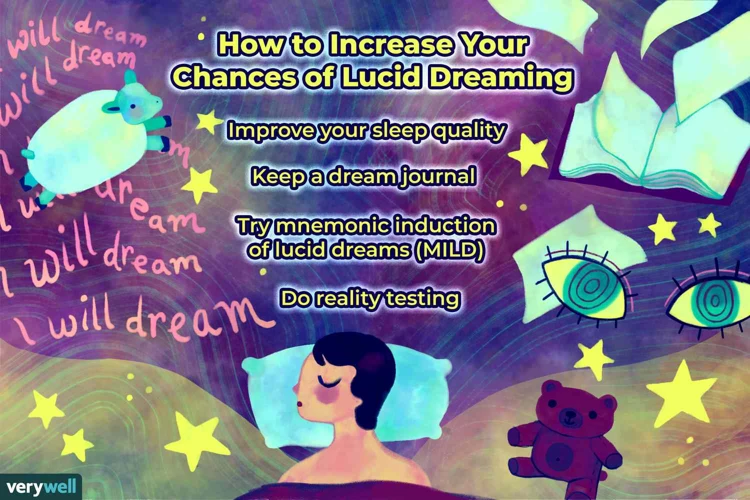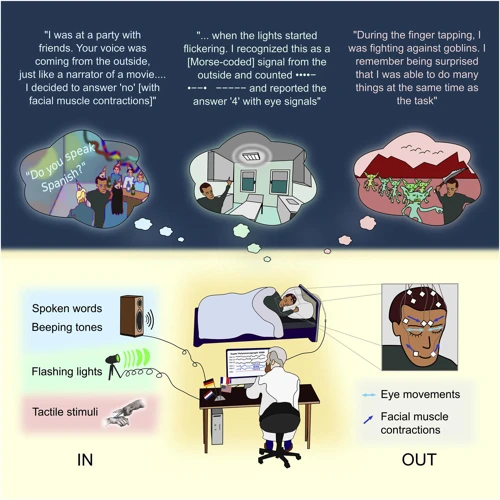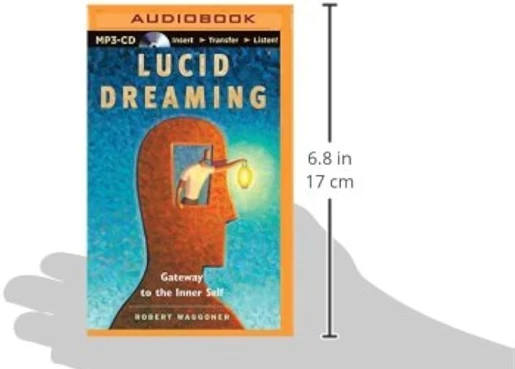What is Lucid Dreaming?

What is lucid dreaming exactly? It is a state of consciousness in which a person becomes aware that they are dreaming while still inside the dream itself. Unlike regular dreams where we passively experience the scenarios playing out in our minds, lucid dreaming gives us the power to actively participate and manipulate the dream environment. This means we can control the outcomes, change the setting, or even fly through the skies like a free bird. Lucid dreams can be highly vivid and realistic, sometimes indistinguishable from waking life. They provide a platform for exploring unlimited possibilities, expanding our consciousness, and delving into the depths of our subconscious mind. It is like having a personal virtual reality experience every time we fall asleep. Lucid dreaming is a powerful doorway to extraordinary experiences and self-discovery. Some individuals even use spiritual symbols in lucid dreaming to gain profound insights and connect with the spiritual realm (link).
The Science Behind Lucid Dreaming

Understanding the science behind lucid dreaming can provide valuable insights into how and why it occurs. One aspect to consider is the different stages of sleep. When we fall asleep, we go through a series of sleep stages, including non-rapid eye movement (NREM) sleep and rapid eye movement (REM) sleep. Lucid dreaming tends to happen during the REM stage, which is characterized by increased brain activity and vivid dreaming. During this stage, the prefrontal cortex (PFC) of the brain, responsible for logic and self-awareness, becomes more active. This heightened activity in the PFC is believed to play a crucial role in attaining lucidity.
Another perspective on the science of lucid dreaming is exploring the neural networks involved. Research suggests that the right dorsolateral prefrontal cortex (rDLPFC) plays a significant role in lucid dreaming. This area of the brain is responsible for critical thinking and self-reflection. Studies using neuroimaging techniques have indicated increased activation in the rDLPFC during lucid dreaming. Additionally, the temporal and parietal lobes, which are associated with sensory perception and self-awareness, have also been found to be more active during lucid dreaming. These neural correlates help shed light on the mechanisms underlying lucid dreaming and the brain regions involved in maintaining consciousness within the dream state.
Lucid dreaming also involves the neurotransmitter acetylcholine. During REM sleep, there is an increase in acetylcholine release, which is linked to enhanced brain activity and vivid dreams. Researchers have found that individuals who experience frequent lucid dreaming have higher levels of acetylcholine receptors, suggesting a potential connection between neurotransmitter function and the ability to become aware within dreams. Understanding the intricate interplay between brain activity, neurotransmitters, and sleep stages provides a foundation for comprehending the science behind lucid dreaming and its potential to expand our consciousness.
The Stages of Sleep and Lucidity
Understanding the relationship between the stages of sleep and lucidity is crucial for harnessing the power of lucid dreaming. Sleep is divided into several stages, including REM (Rapid Eye Movement) sleep and non-REM sleep. Non-REM sleep has three distinct stages: N1, N2, and N3. During the N1 stage, we drift from wakefulness to light sleep, and it is common to experience fleeting and fragmented dreams. The N2 stage is characterized by deeper sleep, with occasional bursts of brain activity and sleep spindles. It is during the REM stage that dreams become more vivid and intense. This is the stage where lucidity is most likely to occur. The brain is highly active during REM sleep, similar to the waking state, and it is the perfect opportunity for lucid dreams to unfold. By practicing lucid dreaming techniques, such as reality checks and dream journaling, we can increase our chances of becoming lucid during REM sleep. It is important to note that the duration and intensity of REM sleep cycles vary throughout the night, with longer REM periods occurring towards morning. Being aware of the sleep cycle can help us optimize our lucid dreaming practice and increase the likelihood of experiencing lucidity.
Lucid Dreaming Techniques
There are several effective techniques you can practice to increase your chances of having lucid dreams. These techniques work by enhancing your self-awareness and training your mind to recognize when you are dreaming. Here are a few popular and proven methods:
- Reality Checks: Perform regular reality checks throughout the day to determine whether you are in a dream or reality. Common reality checks include looking at a digital clock, trying to push your finger through your palm, or questioning your surroundings.
- Keep a Dream Journal: Keep a dream journal next to your bed and write down any dreams you can remember immediately upon waking up. This practice helps you become more attentive to your dreams and can assist in detecting patterns or dream signs that may indicate you are in a dream.
- Reality Testing: Consistently question your reality by asking yourself if you are dreaming or awake. This habit will carry over into your dream state, increasing your chances of realizing that you are dreaming.
- MILD Technique: Mnemonic Induction of Lucid Dreams (MILD) involves waking up after several hours of sleep and repeating a mantra or affirmation to yourself, such as “I will have a lucid dream tonight.” This technique helps program your subconscious mind to recognize the dream state.
- Wake-Back-to-Bed: Set an alarm to wake you up after approximately 4-6 hours of sleep. Stay awake for a short period of time, reflect on your dreams, and then go back to sleep. This method can induce lucid dreams by taking advantage of the REM sleep cycle.
Remember, mastering the art of lucid dreaming takes practice and patience. Experiment with different techniques to find what works best for you. Additionally, maintaining good sleep hygiene, such as getting enough sleep and reducing stress, can greatly enhance your lucid dreaming potential.
Benefits of Lucid Dreaming
Lucid dreaming offers a plethora of benefits that go beyond simply having enjoyable and thrilling dream experiences. One significant advantage is the opportunity to overcome fears and phobias within the safe realm of our dreams. Through lucid dreaming, individuals can confront their fears head-on and practice coping mechanisms, leading to increased confidence and a sense of empowerment. Additionally, lucid dreaming can enhance creativity and problem-solving abilities. As we navigate and shape our dreams, we are exercising our imaginative muscles, which can translate into improved creative thinking in our waking lives. Lucid dreaming also serves as a valuable tool for self-reflection and introspection. By examining the dream symbols and narratives, we can gain insight into our subconscious desires, unresolved conflicts, and hidden emotions. This increased self-awareness can contribute to personal growth and emotional healing. Lucid dreaming has been linked to improved sleep quality and the ability to overcome nightmares. By actively engaging in our dreams, we can reshape the dream narrative and transform frightening experiences into positive ones. Ultimately, the benefits of lucid dreaming extend far beyond the dream world and have the potential to positively impact various aspects of our waking lives.
Exploring Higher Consciousness in Lucid Dreams

Lucid dreaming opens up a fascinating realm for exploring higher consciousness and delving into the depths of our inner selves. When we become aware that we are dreaming, we have the opportunity to recognize the dream state and tap into an expanded level of awareness. This heightened state of consciousness allows us to break free from the limitations of our waking reality and explore the limitless possibilities of our own mind. Through practice and experience, we can enhance our awareness and control within the dream, enabling us to navigate through the dreamscape with intention and purpose. During lucid dreams, we can connect with our inner self, deepening our self-awareness and gaining insights into our subconscious desires, fears, and aspirations. We can also use lucid dreams to manifest and integrate these insights into our waking life, turning dreams into stepping stones towards personal growth and transformation. Lucid dreaming is not just an extraordinary experience; it is a powerful tool for self-exploration and expanding our consciousness beyond the boundaries of our physical reality.
Recognizing the Dream State
One of the key skills in lucid dreaming is recognizing the dream state. It is essential to be able to differentiate between a dream and waking reality to become lucid within the dream. Here are a few methods to help you achieve this:
1. Reality Checks: Perform frequent reality checks throughout the day. These checks involve questioning your surroundings and physical state to determine whether you are awake or dreaming. Some common reality checks include trying to push your finger through the palm of your hand (link), checking the time multiple times, or attempting to read a sentence multiple times to see if it changes.
2. Dream Signs: Pay attention to recurring patterns or situations that frequently occur in your dreams. These are known as dream signs. By keeping a dream journal (link) and recording your dreams regularly, you can identify these patterns. Once you are familiar with your dream signs, they will start to trigger your awareness when they appear in your dreams, leading to lucidity.
3. Mindfulness: Cultivate mindfulness in your waking life, and carry that awareness into your dreams. Stay present and pay attention to your surroundings, sensations, and thoughts. By practicing mindfulness, you will develop a heightened sense of self-awareness, making it easier to recognize when you are dreaming.
By practicing these techniques consistently, you can train your mind to recognize the dream state and increase your chances of achieving lucidity within your dreams. Remember, developing this skill takes time and patience, but with perseverance, you can unlock the gateway to higher consciousness within your dream world.
Enhancing Awareness and Control
Enhancing awareness and control is a fundamental aspect of lucid dreaming. When we become lucid in a dream, we gain the ability to consciously navigate and manipulate the dream environment. It’s like being the director of our own movie or the author of our own story. Here are some techniques for enhancing awareness and control during lucid dreams:
Reality Checks: Engaging in reality checks throughout the day can help train our minds to question whether we are dreaming or not. This habit can carry over into our dreams, increasing the chances of becoming lucid. Common reality checks include looking at our hands, trying to push a finger through our palm, or checking the time on a clock. These reality checks help us differentiate between the dream world and the waking world.
Mindfulness: Practicing mindfulness in waking life can have a direct impact on our level of awareness during lucid dreams. By cultivating a sense of presence in our day-to-day activities, we become more attuned to our surroundings. This mindfulness can carry over into our dreams, allowing us to recognize inconsistencies and trigger lucidity.
Visualizations: Before falling asleep, we can visualize ourselves becoming lucid in a dream. By repeatedly affirming our desire to be aware and in control while dreaming, we set a powerful intention in our subconscious mind. This intention can manifest in our dreams, increasing our awareness and ability to control the dream narrative.
Reality Testing: During a lucid dream, we can further enhance our awareness by engaging in reality testing. This involves examining objects or elements in the dream environment, paying attention to their details, and questioning their authenticity. By doing this, we reaffirm our lucidity and solidify our control over the dream.
Practice: Like any skill, enhancing awareness and control in lucid dreams takes practice. The more we actively engage in lucid dreaming, the more accustomed we become to the state of lucidity. With time and practice, we can develop a higher degree of awareness and control, unlocking the full potential of our lucid dream experiences.
Remember, the key to enhancing awareness and control in lucid dreaming lies in persistence and consistency. By applying these techniques and maintaining a regular lucid dream practice, we can expand our consciousness and embark on incredible adventures within the realm of our dreams.
Connecting with Your Inner Self
Connecting with your inner self is one of the most profound experiences that lucid dreaming can offer. In the lucid dream state, we have the unique opportunity to engage in a direct and intimate conversation with our subconscious mind. This allows us to gain deep insights into our thoughts, emotions, and desires. By consciously interacting with dream characters and dream environments, we can unravel hidden aspects of our psyche and uncover unresolved conflicts or fears. In the lucid dream, we can ask our inner self questions and receive intuitive answers, as if tapping into a well of unlimited wisdom. This process of self-discovery and introspection can lead to personal growth, healing, and self-acceptance. Additionally, connecting with your inner self in lucid dreams can help you develop a stronger sense of self-awareness and authenticity in your waking life. By exploring the depths of your psyche and understanding your true desires and motivations, you can align your waking actions with your inner truth, leading to a more fulfilling and purposeful life. So, next time you find yourself lucid in a dream, take a moment to connect with your inner self and see what insights and revelations await you.
Manifesting and Integrating Insights
When we engage in lucid dreaming, we open ourselves up to receiving valuable insights and wisdom from our subconscious mind. These insights can be transformative and have a profound impact on our waking lives. But it’s not enough to simply have these insights; we must also learn how to manifest and integrate them into our everyday existence. One effective method is to keep a dream journal. By recording our lucid dreams and the insights they provide, we create a tangible reference point for reflection and analysis. This process allows us to identify patterns, symbols, and recurring themes that may hold deeper meaning. Additionally, practicing meditation can help bridge the gap between our dream experiences and waking reality. By setting aside time to reflect on and contemplate the insights gained during lucid dreaming, we can bring them into our conscious awareness and actively work towards implementing them in our lives. It is through this integration that we truly embody the higher consciousness accessed through lucid dreaming.
Beyond the Dreamscape: Applying Insights to Waking Life

Beyond the dreamscape, the insights gained from lucid dreaming have the potential to positively impact our waking lives. One of the key benefits of lucid dreaming is the opportunity to practice and develop skills that can be applied in real-world scenarios. For example, if you have a fear of public speaking, you can use lucid dreaming to rehearse giving a speech in front of a supportive audience. By doing so repeatedly in your dreams, you can build confidence and reduce anxiety when faced with this situation in waking life. Additionally, lucid dreaming can be a platform for problem-solving and creativity. If you’re facing a challenging situation or looking for new ideas, you can pose a question or set an intention before going to sleep, and your dreaming mind may provide unique insights and solutions. By journaling and reflecting on your lucid dreams, you can extract valuable lessons, symbols, and patterns that can inform your actions and decisions in the real world. Remember, the potential of lucid dreaming extends far beyond the boundaries of the dream realm, allowing you to apply its insights to enhance your waking life experiences.
Meditation and Lucid Dreaming: Synergistic Practices

Meditation and lucid dreaming are two powerful practices that can synergize and complement each other in profound ways. Both of these practices involve cultivating awareness and exploring the depths of consciousness. When combined, they can enhance our ability to access higher states of consciousness and deepen our spiritual journey.
One synergistic practice is deepening mindfulness through dream journaling. Keeping a dream journal is a common technique used to enhance dream recall and increase lucidity. By consistently recording our dreams upon waking, we develop a habit of paying attention to the details of our dream experiences. This heightened mindfulness can then be carried into our waking life and meditation practice, as we become more present and aware of our thoughts, emotions, and sensations.
Another way to integrate meditation and lucid dreaming is by using dream symbols for meditation. In lucid dreams, we often encounter symbols that hold personal or archetypal meaning. These symbols can be explored and contemplated during meditation sessions, allowing for a deeper understanding of their significance. By meditating on dream symbols, we can tap into the wisdom and guidance that our subconscious mind often holds.
Lucid dreaming itself can be seen as a portal to spiritual growth through meditation. In a lucid dream, we have the opportunity to consciously connect with our inner selves, explore the nature of reality, and experience profound states of bliss and transcendence. By utilizing meditation techniques within the lucid dream state, such as focused breathing or visualization, we can further enhance our spiritual experiences and delve into higher realms of consciousness.
Meditation and lucid dreaming are complementary practices that can deepen our mindfulness, expand our awareness, and facilitate our spiritual growth. By incorporating these practices into our daily routine, we create a powerful synergy that opens the doors to higher realms of consciousness and self-discovery. So, whether you choose to meditate before bed to induce lucid dreaming or use lucid dreaming as a meditation tool, the combination of these practices is sure to take you on an extraordinary and transformative journey.
Deepening Mindfulness through Dream Journaling
Dream journaling is a powerful tool for deepening mindfulness and enhancing the practice of lucid dreaming. By keeping a dream journal, you establish a habit of reflecting upon and recording your dreams upon waking up. This practice not only helps you remember your dreams in greater detail but also cultivates a sense of awareness and presence in your waking life. When you engage in dream journaling, you begin to notice patterns, recurring themes, and symbols that appear in your dreams. This heightened level of mindfulness carries over into your daily activities, allowing you to recognize and appreciate the subtle nuances of life. By actively engaging with your dreams through journaling, you are strengthening the neural pathways associated with dream recall and lucidity. As you record your dreams, try to be descriptive and include as many details as possible. This exercise not only assists in remembering your dreams but also trains your mind to be more observant and attentive to the present moment, fostering a deepened sense of mindfulness both in and out of the dream world.
Using Dream Symbols for Meditation
When it comes to exploring the depths of our dreams and using them as a tool for meditation, understanding and interpreting dream symbols can be highly beneficial. Dream symbols are the images, objects, or experiences we encounter in our dreams that hold personal or universal meaning. These symbols can range from animals and landscapes to recurring patterns or even specific people. By using dream symbols for meditation, we can gain a deeper understanding of our subconscious mind and access insights that may be elusive in our waking state.
One approach to using dream symbols for meditation is to create a dream symbol journal. This journal can serve as a repository for recording and reflecting upon the symbols that appear in your dreams. Start by writing down any symbols that stand out to you upon waking from a dream. Then, set aside time for meditation where you focus on a specific symbol from your dream. Close your eyes, visualize the symbol, and allow your mind to wander and explore its meaning. You may experience a sense of clarity or receive intuitive insights about the symbol’s significance in your life.
Another technique is to incorporate visualization during meditation. Begin by sitting in a comfortable position and bringing to mind a specific dream symbol. Visualize the symbol in your mind’s eye, focusing on its details, colors, and textures. As you continue to hold the image, allow yourself to enter a state of deep relaxation. Then, explore the symbol within your visualization. Engage with it, ask it questions, and observe how it responds. This practice can help you tap into your subconscious mind and access the wisdom and guidance that the symbol represents.
Remember, the interpretation of dream symbols is highly personal, so it’s important to trust your own intuitive insights. Over time, as you develop a deeper connection with your dreams and practice meditation using dream symbols, you’ll likely uncover hidden meanings, unlock personal growth, and gain a greater sense of self-awareness. So, grab your journal, find a quiet space, and embark on a fascinating journey of self-discovery through the exploration of dream symbols.
Lucid Dreaming as a Portal to Spiritual Growth
Lucid dreaming has long been regarded as a powerful tool for spiritual growth and self-exploration. It provides a unique portal to dive into the depths of our consciousness and connect with the spiritual realm. When we are lucid within a dream, we have the ability to transcend the limitations of the physical world and tap into higher dimensions of existence. This opens up numerous opportunities for spiritual exploration, including encounters with spirit guides, glimpses of past lives, and even visits to the astral realm.
One of the key aspects of lucid dreaming as a portal to spiritual growth is the ability to recognize the dream state. Being aware that we are dreaming allows us to consciously interact with the dream environment and the entities within it. It enables us to ask questions, seek guidance, and receive profound insights from our inner self and higher consciousness. Through lucid dreaming, we can access a wellspring of wisdom and spiritual guidance that is often inaccessible in our waking lives. This connection with the spiritual realm can help us gain a deeper understanding of ourselves and the universe around us.
Lucid dreaming allows us to enhance our awareness and control in order to explore spiritual concepts and experiences. We can consciously set intentions before entering a lucid dream, such as seeking enlightenment, connecting with higher beings, or receiving spiritual teachings. In the dream state, we have the freedom to experiment with different meditation techniques or engage in energy work, such as chakra cleansing or aura healing. These practices can amplify our spiritual growth and accelerate our journey towards higher levels of consciousness.
Lucid dreaming also serves as a platform for manifestation and integration of insights. In a lucid dream, we can intentionally manifest desired outcomes or work through unresolved issues from our past. This provides an opportunity to heal emotional wounds, release limiting beliefs, and cultivate a deeper sense of peace and harmony within ourselves. The insights gained from lucid dreaming can be carried over into our waking lives, impacting our decision-making, relationships, and overall sense of well-being.
Lucid dreaming serves as a profound portal to spiritual growth. It offers us a direct connection to the spiritual realm and the infinite wisdom within us. Through recognition of the dream state, enhancing awareness and control, connecting with our inner self, and manifesting and integrating insights, we can unlock the transformative power of lucid dreaming in our spiritual journeys. It is a realm where the boundaries of reality are blurred, and the potential for self-discovery and growth is infinite.
Lucid Dreaming Communities and Resources
As the popularity and interest in lucid dreaming continue to grow, so do the communities and resources dedicated to this fascinating practice. Being part of a lucid dreaming community can provide invaluable support to individuals on their lucid dreaming journey. It allows for knowledge-sharing, inspiration, and the opportunity to connect with like-minded individuals who share a passion for exploring consciousness through dreaming. Online forums and social media groups are excellent places to find and join lucid dreaming communities, where you can ask questions, share experiences, and learn from others. Additionally, there are numerous websites, books, and podcasts that serve as valuable resources for understanding and honing your lucid dreaming skills. These resources often provide step-by-step guides, advanced techniques, scientific research, and personal stories from experienced lucid dreamers. They can offer guidance and inspiration, helping you to deepen your practice and navigate the exhilarating world of lucid dreaming. So, whether you prefer to connect with others virtually or seek information through books and online resources, there are plenty of opportunities to immerse yourself in the lucid dreaming community and enhance your understanding of this extraordinary practice.
Conclusion
Frequently Asked Questions
What are the different types of lucid dreams?
There are various types of lucid dreams that one can experience. These include ordinary lucid dreams, where individuals are aware of their dreaming state but may not have complete control over the dream; mutual lucid dreams, where two or more people share a lucid dream and can interact with each other; and pre-lucid dreams, which are dreams where individuals have a sense that they are dreaming but haven’t fully recognized it yet.
Is it possible to learn how to lucid dream?
Yes, absolutely! Lucid dreaming is a skill that can be developed through various techniques and practices. With dedication and patience, anyone can learn how to lucid dream and explore the incredible realm of consciousness within their dreams.
What are reality checks and how do they help with lucid dreaming?
Reality checks are simple actions or observations that help determine whether you are dreaming or awake. By incorporating reality checks into your daily routine, such as looking at your hands or trying to push your finger through your palm, you train your mind to question reality. This can carry over into your dream state and increase the likelihood of becoming lucid.
Can lucid dreaming have any potential risks or side effects?
Lucid dreaming is generally considered safe and does not pose any significant risks or side effects. However, it is important to maintain a healthy sleep pattern and prioritize overall well-being. Excessive lucid dreaming or neglecting proper rest can potentially disrupt regular sleep cycles.
Does lucid dreaming have any practical benefits?
Absolutely! Lucid dreaming can have a range of practical benefits. It can be used for creative inspiration, problem-solving, overcoming fears and phobias, practicing skills, and even improving athletic performance. Lucid dreaming provides a unique platform for exploring and enhancing various aspects of our lives.
Can lucid dreaming help with personal growth and self-discovery?
Yes, lucid dreaming is an extraordinary tool for personal growth and self-discovery. It allows us to delve into the depths of our subconscious mind, confront our fears, gain insight into our thoughts and emotions, and connect with different aspects of our psyche. Lucid dreaming offers a profound journey towards self-awareness and self-transformation.
Are there any techniques to extend the duration of lucid dreams?
Yes, there are techniques that can help prolong the duration of lucid dreams. Some common strategies include practicing stabilization techniques like spinning or rubbing your hands together within the dream, deepening your lucidity by engaging with the dream environment, and utilizing the power of intention and visualization to maintain the lucid state.
Can everyone have lucid dreams?
In theory, everyone is capable of having lucid dreams. However, some individuals may naturally have a higher propensity for lucid dreaming, while others may need to invest more time and effort in developing lucid dreaming skills. With practice and perseverance, most people can experience lucid dreams.
Can lucid dreams be used for spiritual exploration?
Absolutely! Lucid dreaming can be a powerful tool for spiritual exploration and deepening one’s connection with the spiritual realm. It can provide opportunities for encountering spirit guides, exploring astral projection, accessing higher dimensions, and gaining profound insights into the nature of consciousness.
Are there any resources available to learn more about lucid dreaming?
Yes, there are plenty of resources available for those who want to dive deeper into the world of lucid dreaming. Books, online forums, websites, and even lucid dreaming workshops are excellent sources for learning techniques, sharing experiences, and connecting with a vibrant community of fellow lucid dreamers.








